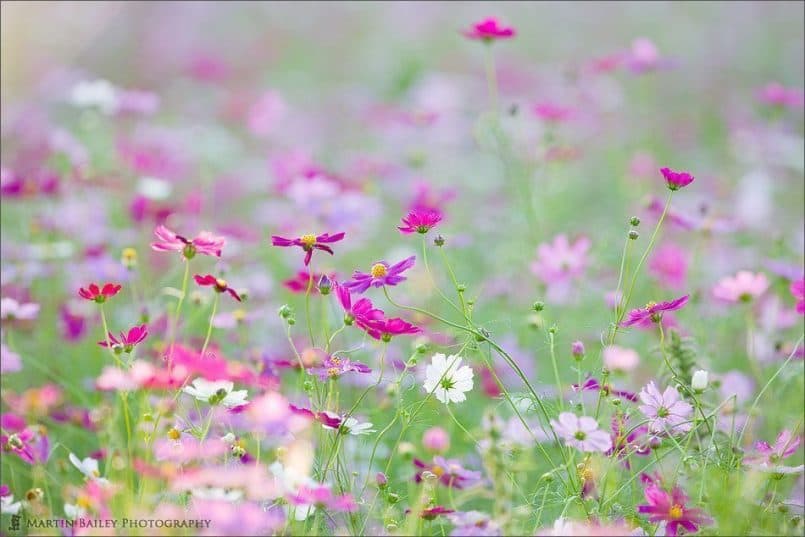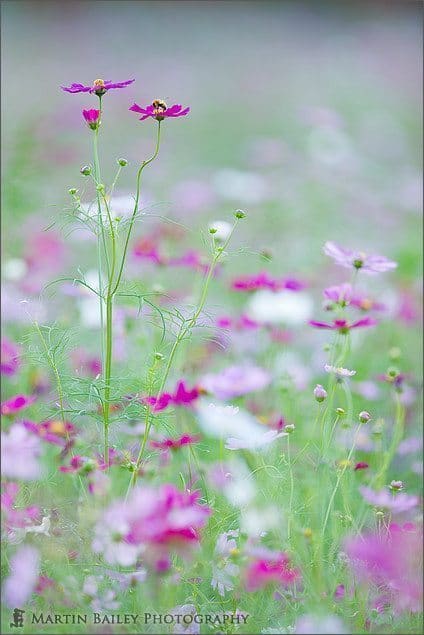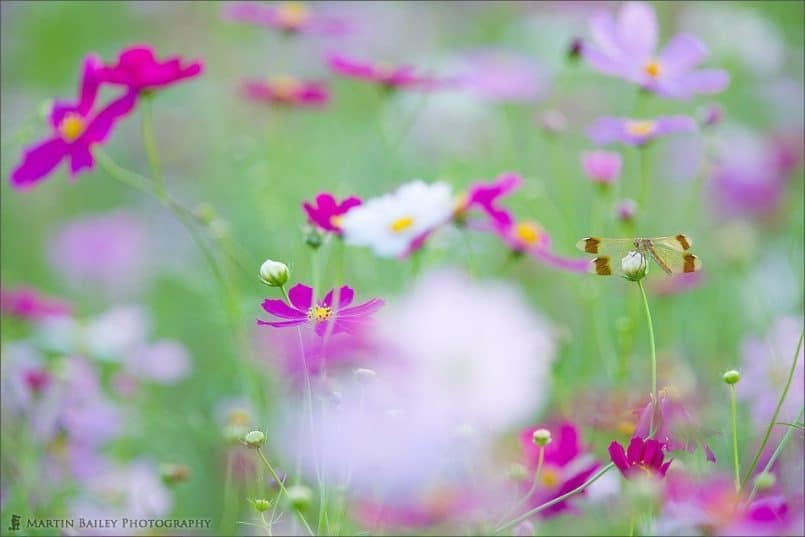Following on from last week’s episode, when we looked at some Equinox flower shots from a place called Kinchakuda, I want to look at some Cosmos flower images that I shot at the end of the day in a field near to the Equinox flowers. I was thinking to also look at some white cosmos shots from a few days later, but I didn’t get a chance to finish processing the shots, so I’ll maybe pick up on those in the future at some point. For now though, let’s look at my Cosmos shots, and I’ll talk a little about the composition and make up of each shot, but also using a series of four shots, I’ll talk you through my thought process as I built up the shots.
If you’ve been following my work at all, you may know that I have a passion for dreamy flowerscapes. One of the reasons I splashed out for the 300mm F2.8 lens was to enable me to shoot these images. They can be done with the 70-200mm F2.8 to an extent, but to really pick out a portion of a field of flowers and make it something special, often takes a little more reach, but still with a nice wide aperture, and I’m loving what I’m capturing with the 300mm F2.8.
I was shooting for literally just 25 minutes at the end of the day, as the sun got low in the sky and then went behind the trees on the horizon. The first image that I uploaded from this series of five shots was image number 1933. The quality of light changes dramatically as the sun stops hitting the flowers directly, and in this first shot, I was just getting into my flowerscape mode. What I basically do is walk along the edge of the field, and peer into the flowers, looking for something that stand out to me. Here I’d just found some purple cosmos flowers that were sticking up slightly higher than those around them, which is always a good start. There was also that one tall purple flower in the distance, which was going to help to add interest to the background. I’m also looking for stuff that might clutter the background, as I want nice bokeh without too many distractions. At the Web size, you might not be able to fully appreciate this, but on a large print or a large full screen, the other thing that I’m doing here is basically just giving you lots of points of interest to poor over. When you look into this shot, there is so much on the focal plane that you can search through for quite a long time just enjoying the detail, standing out against the dreamy background bokeh. This is not that great an example though. As I say, I was just getting started here, getting my eye in, and searching for something more.
I walked a few meters to the right, and noticed some more flowers that were again, a little higher than the surrounding ones, and so again pointed my lens in their general direction, and set up another shot. In image number 1934, because of the tallness of the two purple flowers to the left, and the nicely position pink flower to the right, I decided to shoot them in portrait mode, as opposed to horizontally in landscape mode. I opened up the aperture from F4 in the last shot, to F3.5 now, and we’re getting slightly dreamier bokeh, and even less distracting background. There are some nice patches of white and pink in the green though, and I now have placed a few flower in the foreground too, helping to add some foreground bokeh, and make the two purple flowers and their stalks stand out much more. Now what we’re getting is much better composition, and if you look, here I was lucky enough to have a bee come in, gathering pollen from the right flower of the two purple cosmos. This is not the one that I was focusing on, and I didn’t have time to refocus, but still, it’s sharp enough to be a nice addition to the shot. Having shot these cosmos images quite often now, I very much welcome a little something extra like this.
This is why I was very pleased as I walked along a little further, and found a dragonfly perched on a Cosmos flower bud that was just about ready to open, and we can see the first shot of this in image number 1935. As I have no control over where the dragonfly is, I now have to start to compose my image around it instead of just basing my composition on where the flowers are. Before this shot, I actually had a bit of flower overlapping the right wings of the dragonfly, and although it looked nice, with the foreground bokeh, I moved to the left just a tad, and gave myself a totally clear view of the dragonfly for this shot. You’ll notice that I have positioned the purple flower in the top left, moved vertically to make it about the same distance from the top of the frame as the side. I also had to step back by about two meters to give myself a bit of space after the flower to the right. I have to admit, I didn’t even see the butterfly that was sitting on that flower when I was setting up the shot. I think it came in for just a few frames, then flew away again, but this adds so much to the final image, especially when printed out, that I felt really lucky that it dropped by to see us. Still at F3.5, there are plenty of things along the plane of focus here to look at, so again this is a great shot to just poor over. I printed this out one night last week at 13×19” and it literally had the hair on the back of my neck standing up, and invoked one of those mad scientist types of laughter as I checked out the detail. The dragonfly is incredibly sharp, and really stands out well. There is a flower between us and the butterfly, making it appear sort of semi-transparent, adding to the whole dreamy effect. The shutter speed for this shot was 1/50th of a second, and the ISO 100. It was a lovely still day, so I didn’t have to contend with the flowers blowing around in the breeze.
Although we’re going to go on to look at two more shots, to continue to explore my thought process as I work the shot, this is my favourite. Of course, you don’t always know that you have nailed the shot, and unless you do, I advise you to continue to shoot, as long as time and energy allow. You never know when you are going to improve on your last shot. Sometimes you don’t improve on it, but you can continue to make images of value. Other times, your best shot is so obvious that you know you can pack up and go home, but there are times when it just isn’t obvious, so I keep shooting. After all though, we’re still only talking about a 25 minute session at the end of a day shooting something else here. Still, I think when I do my wrap up of 2008 in December, you will see this as one of my top 5 shots for this year, without a doubt.
The dragonfly was staying put, just rotating his head around a little every so often, so trying to increase my portfolio with both vertical and horizontal shots, I flipped the lens around in the tripod mount ring, and started to look for a vertical version. If you get both this shot and the next, image number 1936, up on your computer screen together, or flip back and forth between them now, you’ll see that I have moved back to the left by around a meter or so. In the horizontal or landscape version, there simply isn’t enough in the scene to make the shot interesting. Just a dragonfly alone is wasting an excellent opportunity to make something special. As I rotate around to the left though, it brings in that pale pink flower on the left and the pink flower behind the white one in the last shot, into the left and right sides of the image, in the foreground and background. I’ve mentioned before about taking care of your bokeh, and this is a prime example. Just because something is out of focus, it cannot be ignored, or you’re wasting opportunity. Note too that at this point, I dropped the 1.4X extender or teleconverter between my camera and lens, so I’m shooting at 420mm now, to get in even close and maximize on the elements in the frame. The dragonfly is still over there on the right side, sitting patiently while I finished my shots, and the foreground bokeh has lots of interest with the patches of colour. There are lots of nice semi-focused cosmos flower in the background too, and plenty of detail across the plane of focus.
Finally, in image 1937, now that I have the 1.4X Extender on, I swung a little to the left again to re-include the two purple cosmos flowers from the earlier composition, but this time they are taking up the top left corner, and there’s some nice patches of colour in the bokeh below that along the left side. This is not as good a picture in my mind as the second one we looked at, but still pretty nice with lots of shapes and stuff to look at, and even with the extender, the dragonfly is still incredibly sharp here. As the light dropped, I was shooting at 1/20th of a second now, with F4, the maximum aperture with the extender fitted, so still pleased that there was no wind.
I wanted to quickly recap that I am most definitely exposing for the highlights here, which is pretty much a norm for me now. As the light drops, you have to make a choice as to whether or not to show the subject as it is, getting gradually darker, or allow the light to build up a little more, lightening the shot. Sometimes, I use the darkness to add mood, as I recall doing when shooting the Red Crowned Cranes in near dark at the end of 2006. For this sort of shot though, waiting until the sun is below the horizon and allowing the still illuminated sky to light the scene with much less contrast, then using the exposure to bring the colours back out, really works for me. So despite there actually being less light, I still expose the shots so that the histogram just about touches the right edge. This helps to give this dreamy effect, along with the bokeh from using the lens wide open or close to it.
I think that each of these images does stand up by itself, or I wouldn’t have uploaded them to my gallery, but also I thought it would be worth walking you through how the shots evolved through what turned out to be what I think is the best of the batch, and moving through and exploring other possibilities. As I say, sometimes you just know when you have nailed it, and others, you need to explore other possibilities, just to make sure.
On the whole concept of what I’m calling “flowerscapes”, I’m finding that now more than ever, with the resolution of the 1Ds Mark III, and that which many more will be enjoying soon with the 5D Mark II, I’m tending to enjoy the details within the details. I’ve enjoyed shooting these flowerscapes for some time now, but as we get more and more resolution, it is just so much more gratifying to peer, well, actually almost delve into the details of a good quality print. Although I still enjoy Macro work, I’m finding more enjoyment in looking at the detail in the dragonfly as a much smaller portion of a larger scene, than just a close-up of the dragonfly. It’s like the crane dancing in the distance in one of my shots from Hokkaido in January 2008. Having the resolution to be able to look up close and count all of the wing feathers on a bird only 12mm tall on a 13×19” print is just something else. It’s changing my photography, and the only thing that I am not happy about, is that the only way you can appreciate this in my photos without buying a print, would be for me to publish the full sized images on line. This I’m never going to do of course, but the Web version just does not do them justice, which is frustrating, but that’s how it is I guess.
Just a few more things to add before we close. One is that I’ve tagged a whole bunch of flower shots in my online gallery at martinbaileyphotography.com with the flowerscape keyword. I’ll put a link into the show-notes to display all of the tagged images. I’m not suggesting that you look at them all, but if you are interested, take a look at the thumbnails, and open a few that you want to see more of. The reason I’ve done this, and the reason I thought it might be interesting to you is just to see how our photography evolves over time. It was interesting to go through my flowers album and see which could be tagged. Actually having done an initial tagging, I went back through and removed the ones that just didn’t fit in the list, and there was a lot, despite me trying to shoot this sort of image for a few years now. I do another cull as I release this episode, as some that remain still don’t fit for what I’m dubbing flowerscapes. Another thing I noticed was how much better these shots have become since getting the 70-200mm which took them much further than my first attempts with my 100-400mm lens, then in turn, how much better these shots have become now I’m shooting many of them with the 300mm F2.8. People will tell you that it’s not about the equipment, but I can tell you, it’s all about the equipment, when you have a specific purpose in mind. I agree that we should not get hung up on gear, for gear’s sake, but if you have a clear problem to solve to realize your vision, then it may be that you have to pick up something to help you achieve that. These shots are simply not possible with your kit lens standard zoom. Sure, I feel lucky in that I am able to add lenses like this to my kit, but as I do, I realize more and more that it’s so much more about the equipment than many would like to admit.
So that’s it for this week. Let’s wrap it up there, with one quick reminder to look at the mbpworkshops.com Web site if you are interested in joining me in Hokkaido for a nine day photography tour and workshop shooting wildlife and winter landscapes in the best location for this type of photography on the planet. For those that cannot make the full nine days, there’s a drop out option in the middle of the fifth day, after the majority of the wildlife shooting is done. For full details, check out the mbpworkshops.com web site.
And with that, all that remains to be said is you have a great week, whatever you’re doing. Bye-bye.
Show Notes
The music in this episode is from the PodShow Podsafe Music Network at http://music.podshow.com/
Subscribe in iTunes for Enhanced Podcasts delivered automatically to your computer.
Download this Podcast in MP3 format (Audio Only).
Download this Podcast in Enhanced Podcast M4A format. This requires Apple iTunes or Quicktime to view/listen.








0 Comments